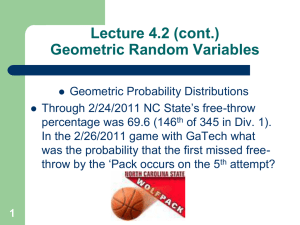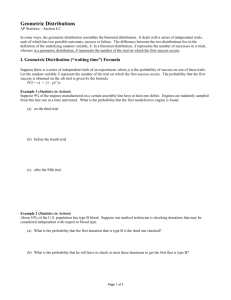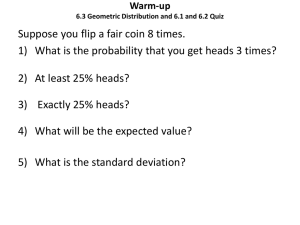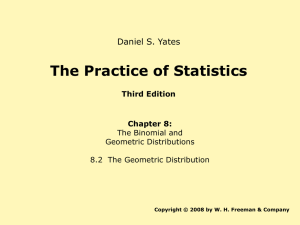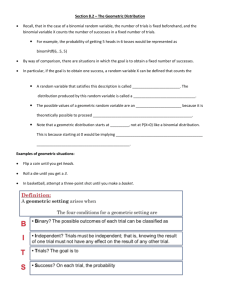Handout 3
advertisement
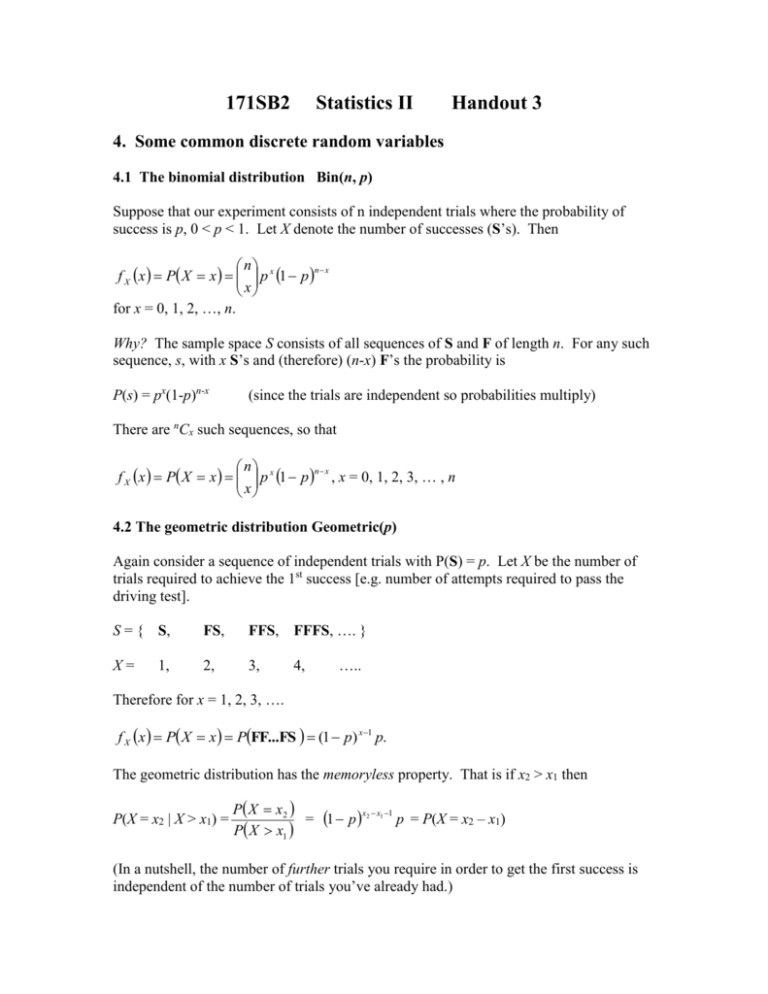
171SB2
Statistics II
Handout 3
4. Some common discrete random variables
4.1 The binomial distribution Bin(n, p)
Suppose that our experiment consists of n independent trials where the probability of
success is p, 0 < p < 1. Let X denote the number of successes (S’s). Then
n
n x
f X x P X x p x 1 p
x
for x = 0, 1, 2, …, n.
Why? The sample space S consists of all sequences of S and F of length n. For any such
sequence, s, with x S’s and (therefore) (n-x) F’s the probability is
P(s) = px(1-p)n-x
(since the trials are independent so probabilities multiply)
There are nCx such sequences, so that
n
n x
f X x P X x p x 1 p , x = 0, 1, 2, 3, … , n
x
4.2 The geometric distribution Geometric(p)
Again consider a sequence of independent trials with P(S) = p. Let X be the number of
trials required to achieve the 1st success [e.g. number of attempts required to pass the
driving test].
S = { S,
FS,
FFS, FFFS, …. }
X=
2,
3,
1,
4,
…..
Therefore for x = 1, 2, 3, ….
f X x P X x PFF...FS (1 p) x1 p.
The geometric distribution has the memoryless property. That is if x2 > x1 then
P(X = x2 | X > x1) =
P X x2
x x 1
= 1 p 2 1 p = P(X = x2 – x1)
P X x1
(In a nutshell, the number of further trials you require in order to get the first success is
independent of the number of trials you’ve already had.)
4.3 The negative binomial distribution NBin(r, p) (a more general version of the
geometric distribution)
Consider the same sequence of independent trials as in 4.2 and let X denote the number of
trials required to achieve r successes, where r can be any positive integer. Clearly the
range of X is r, r+1, r+2. What is fX(x)= P(X = x), x r?
Let s be an outcome for which X(s) = x. Then s is a sequence of S’s and F’s such that:
1. s has length x
2. s has r S’s and x-r F’s
3. the last entry is S.
From 2., P(s) = (1-p)x-rpr (independence of trials!!). How many such outcomes are there?
Picture:
Trial: 1
2
3
…
(x-1) x
Result: ?
?
?
?
S (from 3.)
{(r-1) S’s
&
(x-r) F’s
}
There are (x-1)C(r-1) ways of assigning the S’s to position 1, 2, …, x-1.
Therefore
x 1
1 p x r p r
f X x P X x
r 1
Relationship to geometric distribution
The NBin(1, p) is the same as the Geometric(p) distribution. Also we have that if X1, X2,
…, Xr are independent random variables each with distribution Geometric(p), then Y = X1
+ X2 + … + Xr has distribution NBin(r, p).
4.4 The Poisson distribution (Poisson())
This is a distribution which is often used to describe the outcomes of experiments that
involve counting objects or events (e.g. the number of road accidents occurring on a
stretch of road in a 1-month period). Its range is {0, 1, 2, 3, …..}, and its probability
function is
e x
f X x P X x
, x = 0, 1, 2, 3, ….
x!
It has connections with the Bin(n, p) distribution, and also the Exponential distribution
(see later).




